


C57BL/6-Tnftm1(TNF)Bcgen Il17atm1(IL17A)Bcgen/Bcgen • 120548
| Product name | B-hTNFA/hIL17A mice |
|---|---|
| Catalog number | 120548 |
| Strain name | C57BL/6-Tnftm1(TNF)Bcgen Il17atm1(IL17A)Bcgen/Bcgen |
| Strain background | C57BL/6 |
| Aliases | TNF (tumor necrosis factor, TNFA); IL17A (interleukin 17A) |
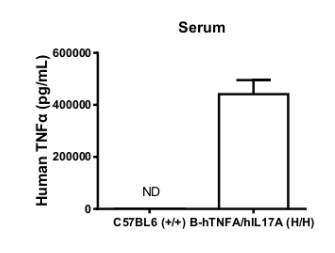
Strain specific TNFα expression analysis in homozygous B-hTNFA/hIL17A mice by ELISA. Serum were collected from WT and homozygous B-hTNFA/hIL17A (H/H) mice stimulated with LPS in vivo, and analyzed by ELISA with species-specific TNFα ELISA kit. Mouse TNFα was detectable in WT mice. Human TNFα was exclusively detectable in homozygous B-hTNFA/hIL17A, but not in WT mice. ND: Not detected.
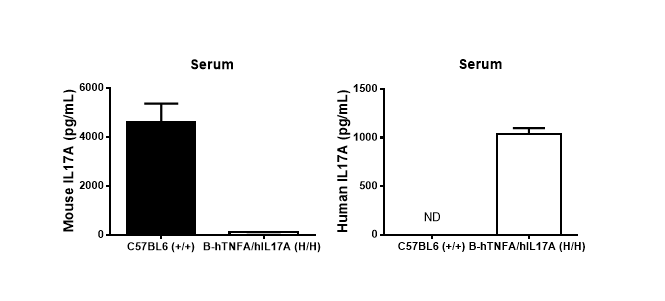
Strain specific IL17A expression analysis in homozygous B-hTNFA/hIL17A mice by ELISA. Serum were collected from WT and homozygous B-hTNFA/hIL17A (H/H) mice stimulated with anti-mCD3 antibody and anti-mCD28 antibody in vivo, and analyzed by ELISA with species-specific IL17A ELISA kit. Mouse IL17A was detectable in WT mice. Human IL17A was exclusively detectable in homozygous B-hTNFA/hIL17A, but not in WT mice. ND: Not detected.

Analysis of spleen leukocyte subpopulations by FACS. Splenocytes were isolated from female C57BL/6 and B-hTNFA/hIL17A mice (n=3, 6-week-old). Flow cytometry analysis of the splenocytes was performed to assess leukocyte subpopulations. A. Representative FACS plots. Single live cells were gated for CD45 population and used for further analysis as indicated here. B. Results of FACS analysis. Percent of T, B, NK, Monocyte, DCs and macrophage cells in homozygous B-hTNFA/hIL17A mice were similar to those in the C57BL/6 mice, demonstrating that introduction of hTNFA and hIL17A in place of its mouse counterpart does not change the overall development, differentiation or distribution of these cell types in spleen.
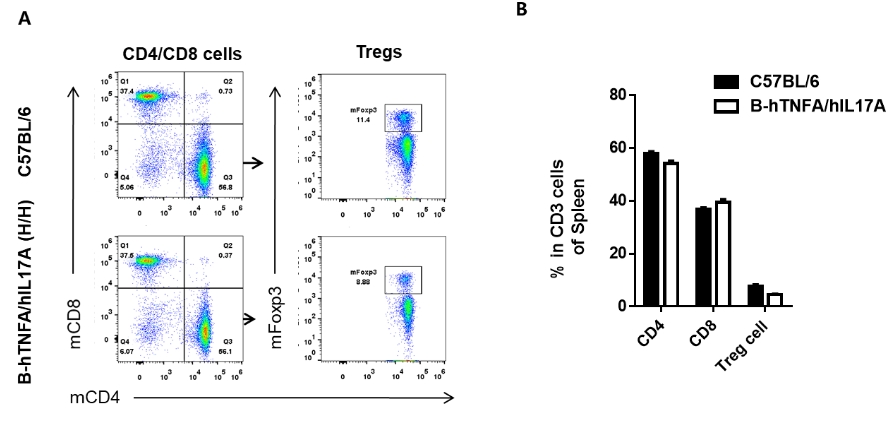
Analysis of spleen T cell subpopulations by FACS. Splenocytes were isolated from female C57BL/6 and B-hTNFA/hIL17A mice (n=3, 6-week-old). Flow cytometry analysis of the splenocytes was performed to assess leukocyte subpopulations. A. Representative FACS plots. Single live CD45+ cells were gated for CD3 T cell population and used for further analysis as indicated here. B. Results of FACS analysis. Percent of CD8+, CD4+, and Treg cells in homozygous B-hTNFA/hIL17A mice were similar to those in the C57BL/6 mice, demonstrating that introduction of hTNFA and hIL17A in place of its mouse counterpart does not change the overall development, differentiation or distribution of these T cell sub types in spleen. Values are expressed as mean ± SEM.
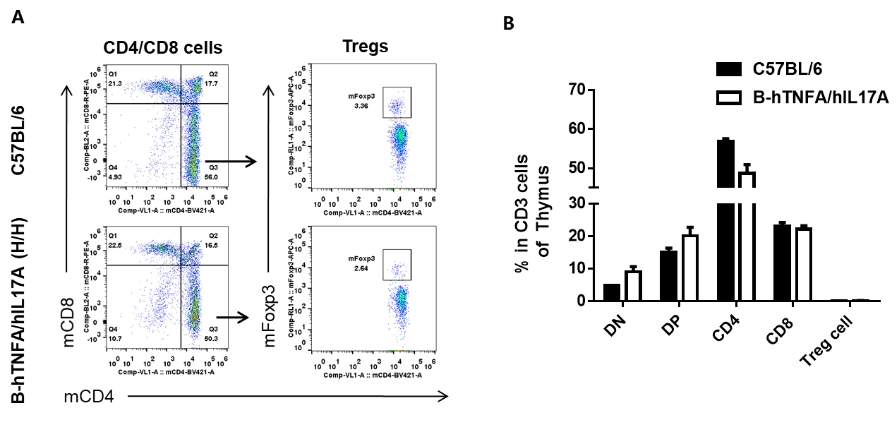
Analysis of thymus T cell subpopulations by FACS. Thymocytes were isolated from female C57BL/6 and B-hTNFA/hIL17A mice (n=3, 6-week-old). Flow cytometry analysis of the thymocytes was performed to assess leukocyte subpopulations. A. Representative FACS plots. Single live CD45+ cells were gated for CD3 T cell population and used for further analysis as indicated here. B. Results of FACS analysis. Percent of CD4+ T cells, CD8+ T cells and Treg cells in homozygous B-hTNFA/hIL17A mice were similar to those in the C57BL/6 mice, demonstrating that introduction of hTNFA and hIL17A in place of its mouse counterpart does not change the overall development, differentiation or distribution of these T cell sub types in thymus. Values are expressed as mean ± SEM.
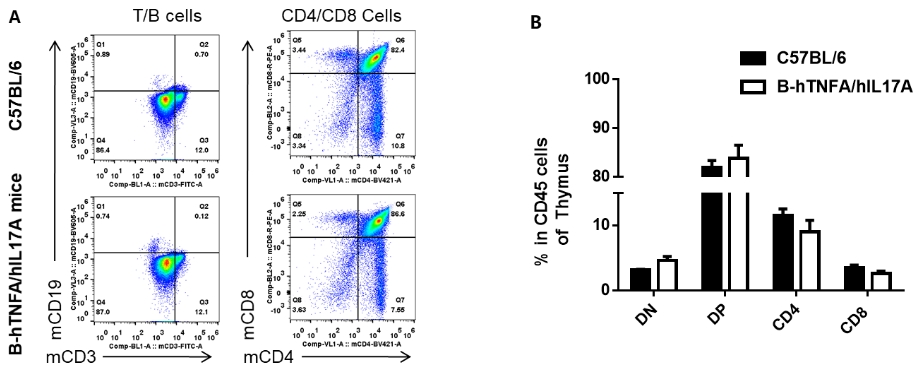
Analysis of thymus leukocyte subpopulations by FACS. Thymocytes were isolated from female C57BL/6 and B-hTNFA/hIL17A mice (n=3, 6-week-old). Flow cytometry analysis of the thymocytes was performed to assess leukocyte subpopulations. A. Representative FACS plots. Single live cells were gated for CD45 population and used for further analysis as indicated here. B. Results of FACS analysis. Percent of CD4+ T cells, CD8+ T cells and B cells in homozygous B-hTNFA/hIL17A mice were similar to those in the C57BL/6 mice, demonstrating that introduction of hTNFA and hIL17A in place of its mouse counterpart does not change the overall development, differentiation or distribution of these cell types in thymus.
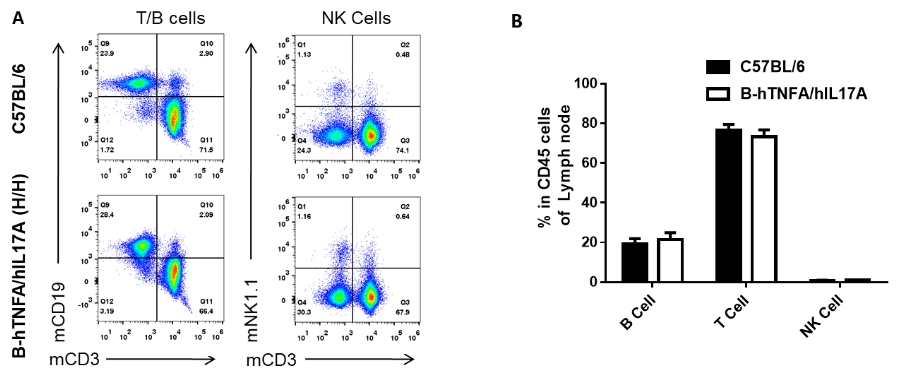
Analysis of lymph node leukocyte subpopulations by FACS. Leukocytes were isolated from female C57BL/6 and B-hTNFA/hIL17A mice (n=3, 6-week-old). Flow cytometry analysis of the leukocytes was performed to assess leukocyte subpopulations. A. Representative FACS plots. Single live cells were gated for CD45 population and used for further analysis as indicated here. B. Results of FACS analysis. Percent of T, B and NK cells in homozygous B-hTNFA/hIL17A mice were similar to those in the C57BL/6 mice, demonstrating that introduction of hTNFA and hIL17A in place of its mouse counterpart does not change the overall development, differentiation or distribution of these cell types in lymph node.
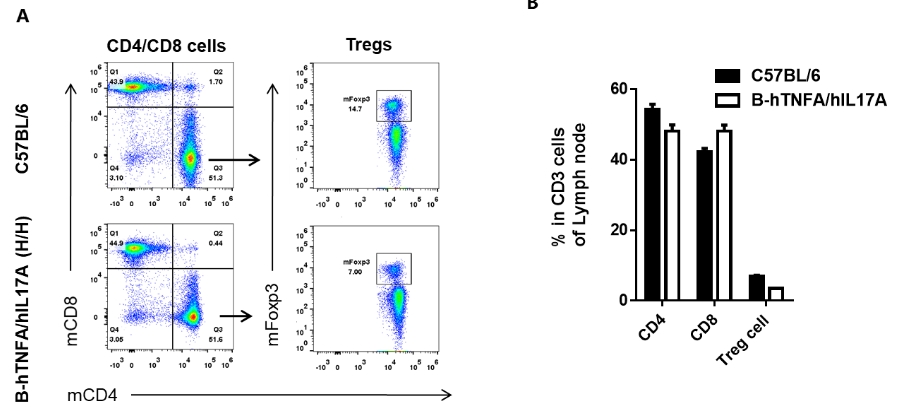
Analysis of lymph node T cell subpopulations by FACS. Leukocytes were isolated from female C57BL/6 and B-hTNFA/hIL17A mice (n=3, 6-week-old). Flow cytometry analysis of the leukocytes was performed to assess leukocyte subpopulations. A. Representative FACS plots. Single live CD45+ cells were gated for CD3 T cell population and used for further analysis as indicated here. B. Results of FACS analysis. Percent of CD8, CD4, and Treg cells in homozygous B-hTNFA/hIL17A mice were similar to those in the C57BL/6 mice, demonstrating that introduction of hTNFA and hIL17A in place of its mouse counterpart does not change the overall development, differentiation or distribution of these T cell sub types in lymph node. Values are expressed as mean ± SEM.
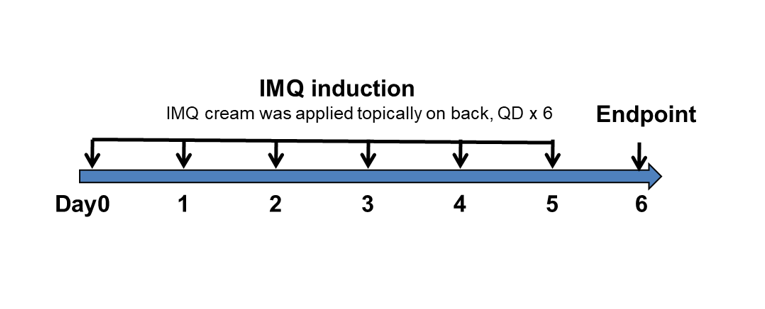
Experimental schedule for induction of psoriasis-like skin lesions in B-hTNFA/hIL17A mice. Mice at 10 to 12 weeks of age received a daily topical of commercially available IMQ cream on the shaved back for 6 consecutive days to induce psoriasis-like skin lesions. Severity of skin inflammation was daily scored and back skin was collected at the endpoint. IMQ: imiquimod.

IMQ-induced skin inflammation in B-hTNFA/hIL17A mice phenotypically resembles psoriasis. B-hTNFA/hIL17A mice (female, 10-week-old, n=5) were scored daily for up to 6 days for body weight and clinical signs of skin inflammation following treatment with imiquimod (IMQ) cream. Mice in each group were treated with different dose of antibodies produced in house. Doses are shown in legend. (A) Phenotypical presentation of mouse back skin after 6 days of treatment. (B) Body weight changes during treatment. (C-D) Erythema and scaling score of the back was scored daily on a scale from 0 to 4. Additionally, the cumulative score (erythema plus scaling) is depicted. Values are expressed as mean ± SEM.
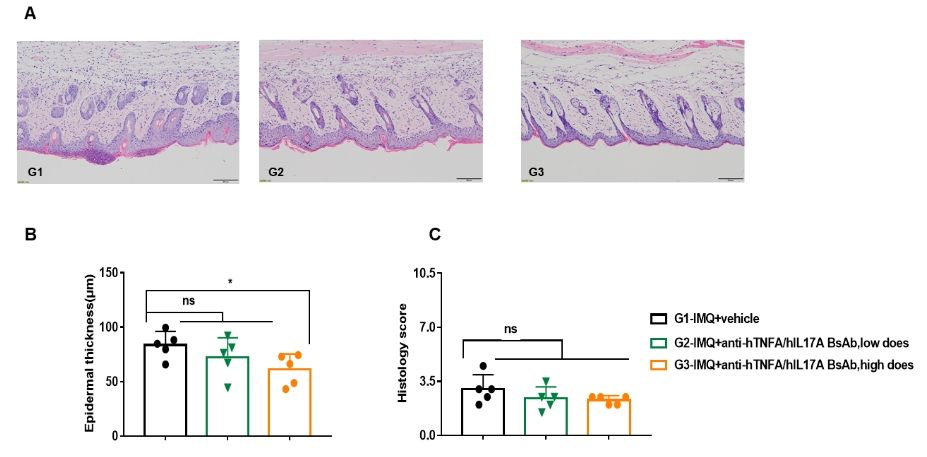
Dose dependent effects of BsAbs on keratinocyte proliferation and inflammatory cell infiltration in IMQ induced psoriasis-like skin lesions in B-hTNFA/hIL17A mice. Back skin was collected at the endpoint and stained with Hematoxylin and eosin (H&E). (A) H&E staining of the back skin. (B) Epidermal thickness of the mice. (C) Histological changes were scored on a scale from 0 to 11. Results indicated that high-dose anti-hTNFA/hIL17A BsAbs (in house) significantly reduced psoriasis-like skin lesions in B-hTNFA/hIL17A mice, confirming that B-hTNFA/hIL17A mice provide a powerful model for in vivo evaluation of anti-human TNFA and IL17A bispecific antibodies.